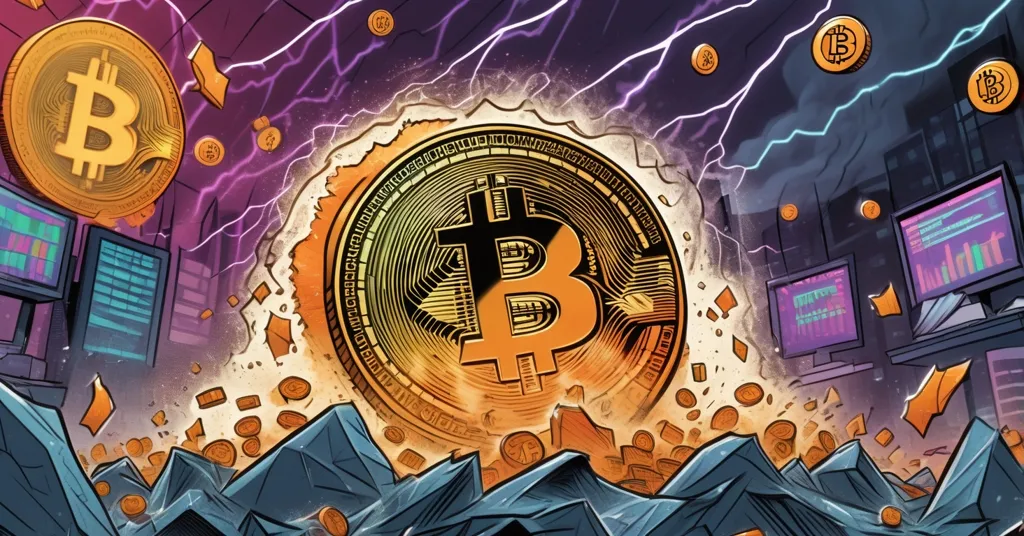Bitcoin Falls Below $103K as RWA, NFTs Surge Amid Fraud and Regulatory Chaos – Nov 13, 2025

Bitcoin Drops Below $103K as RWA and NFT Tokens Surge Amid Fraud and Regulatory Storms – Nov. 13, 2025
Chaos reigns in the crypto markets on November 13, 2025, with Bitcoin slipping below $103,000 while niche sectors like Real World Assets (RWA) and NFTs post surprising gains. Beyond the price action, major scandals—a $456 million TrueUSD fraud freeze in Dubai, a brazen attack on Hyperliquid, and regulatory heat in Japan—remind us that the road to decentralization is anything but smooth. Add in cooling institutional sentiment with massive ETF outflows and a cryptic tease from “Big Short” legend Michael Burry, and you’ve got a day that captures crypto’s exhilarating, messy promise.
- Market Split: RWA up 2.05%, NFTs up 2.01% with Zora (ZORA) soaring 19.5%, while Bitcoin falls 0.8% below $103K.
- Scandal Central: Dubai freezes $456M in TrueUSD fraud; Hyperliquid loses $4.9M to $POPCAT manipulation.
- Regulatory and Institutional Shifts: Japan tightens rules on Bitcoin-hoarding firms; Bitcoin and Ethereum ETFs see heavy outflows.
Market Snapshot: Niche Sectors Shine as Bitcoin Stumbles
The cryptocurrency market on November 13, 2025, is a tale of two worlds. On one hand, Bitcoin (BTC), the bedrock of this space, dropped 0.8% to just under $103,000, a pullback that’s got traders scratching their heads after recent highs. Ethereum (ETH), the second-largest crypto by market cap, managed a modest 0.56% gain, hovering around $3,400. Yet, while the giants show mixed results, lesser-known sectors are stealing the show. Real World Assets (RWAs)—tokens tied to tangible things like real estate or commodities—surged 2.05%. For the uninitiated, RWAs link blockchain to real-world value; think a token representing a stake in a Manhattan apartment building or a gold reserve. Leading the charge, Sky (SKY) jumped 9.01% and Keeta (KTA) climbed 5.32%, hinting at either speculative hype or genuine interest in tokenized assets as inflation hedges.
NFT tokens, tied to digital collectibles and art on the blockchain, also flexed muscle with a 2.01% rise. Zora (ZORA) led with a staggering 19.5% spike, possibly fueled by renewed cultural buzz or platform-specific adoption—trading volume for NFTs has reportedly ticked up this week on major marketplaces. Then there’s PayFi, a sector focused on decentralized payment solutions, up 1.51% thanks to Telcoin (TEL) rocketing 61.7%. This could signal growing appetite for blockchain as a backbone for financial services, a niche Bitcoin doesn’t directly serve. Meanwhile, meme coins and Layer 1 protocols—foundational blockchains like Solana or Avalanche—saw minor dips, though privacy coin Zcash (ZEC) and the oddball Giggle Fund (GIGGLE) posted small gains. For the latest market updates, check out today’s crypto news.
As Bitcoin maximalists, we’re thrilled to see BTC’s dominance, but let’s not pretend altcoins don’t matter. These gains in RWAs, NFTs, and PayFi show the ecosystem’s strength lies in diversity—filling gaps Bitcoin can’t, and shouldn’t, address. Still, skeptics argue these sectors might just be speculative bubbles repackaged; hard adoption numbers are murky at best. Is this a sign of a maturing market or just the latest pump-and-dump craze? The jury’s out, but for now, these niches are keeping the crypto flame burning even as Bitcoin cools off. And let’s be real—$103K isn’t a crisis, it’s a correction. BTC’s fundamentals haven’t crumbled overnight.
Fraud Alert: TrueUSD’s $456M Freeze Shakes Stablecoin Trust
Stablecoins are supposed to be the boring, dependable cousins of crypto—pegged to fiat like the U.S. dollar to offer stability amid volatility. Turns out, they can throw a scandalous party too. On November 13, 2025, a Dubai court dropped a bombshell, issuing a worldwide freezing order on $456 million tied to fraud involving Techteryx, the issuer of TrueUSD (TUSD). The court accused entities like ARIA DMCC of siphoning off reserves, a move that guts the trust underpinning stablecoins. Justin Sun, a polarizing crypto figure who bailed out TUSD holders earlier this year, commented on the progress via Twitter:
“Six months after our announcement to bail out all public holders of TUSD, where US$456m of US Dollar reserves were siphoned-off by a group of fraudsters involving ARIA group, First Digital Trust and Legacy Trust, among others, I am pleased to see that progress has been made in…”
Sun’s involvement raises questions—his track record isn’t exactly spotless—but the bigger issue is systemic. Stablecoins like TUSD are marketed as safe harbors, yet this fraud exposes how fragile that promise can be. For newcomers, the concept is simple: a stablecoin’s value relies on reserves backing it. If those reserves vanish due to fraud or mismanagement, the token’s peg collapses, and so does user confidence. This isn’t just a Techteryx problem; it’s a black eye for the entire industry pushing for mainstream adoption. How can we pitch crypto as the future of money when even the “safe” assets get looted?
On the flip side, some argue this is a necessary purge—bad actors getting exposed could force better transparency and audits across stablecoin issuers. But that’s cold comfort for anyone burned by TUSD. As champions of decentralization, we see the need for trustless systems more than ever. Centralized stablecoins are a halfway house—useful, but flawed. This scandal screams for fully decentralized alternatives, though they come with their own headaches. Trust in crypto often hinges on the weakest link, and right now, that link is looking damn rusty.
DeFi Dangers: Hyperliquid’s $4.9M Loss to $POPCAT Manipulation
Think decentralized finance (DeFi) is all freedom and no consequence? Hyperliquid’s latest nightmare says otherwise. On November 13, 2025, this decentralized perpetuals exchange got hit by a market manipulation attack involving $POPCAT, a meme-inspired token. According to Lookonchain on Twitter:
“Someone just manipulated $POPCAT to attack #Hyperliquid, burning through $3M of their own funds — and causing $4.9M in losses for the Hyperliquidity Provider (HLP).”
Here’s the layman’s take: the attacker spent $3 million, withdrawn as USDC from OKX, to rig $POPCAT’s price, exploiting Hyperliquid’s liquidity pool—a shared pot of funds that enables trading. Think of it as stacking a small-town lottery to drain the prize pool, except here it’s millions in crypto. The result? A $4.9 million loss for Hyperliquid’s liquidity providers. Details like massive $HYPE long positions are less important than the core lesson: DeFi’s open nature is a double-edged sword. It offers freedom from centralized gatekeepers but often leaves doors wide open for bad actors to wreak havoc.
This isn’t just a glitch—it’s a flaming neon sign that DeFi’s wild west needs sheriffs, stat. Thin liquidity and complex mechanisms are ripe for abuse, and Hyperliquid’s pain is a warning to every project: security isn’t optional, it’s existential. Recovery is possible with tighter safeguards and community trust, but incidents like this fuel critics who call DeFi a scammer’s playground. On the other hand, let’s not overreact—centralized exchanges get hacked too, often for bigger sums. DeFi’s ethos of user control remains worth fighting for, but only if we stop pretending the risks aren’t real. Innovation without vigilance is just reckless gambling.
Regulatory Radar: Japan Clamps Down on Bitcoin-Hoarding Firms
Japan, a hub for crypto experimentation, is sending chills through the market with plans to tighten rules on publicly traded companies hoarding Bitcoin. The Japan Exchange Group (JPX) is responding to heavy retail investor losses tied to these firms, with 14 listed companies holding BTC as a treasury asset. The biggest, Metaplanet, is down 75% from its June 2025 peak—a brutal hit for shareholders. JPX is mulling stricter backdoor-listing enforcement and re-audits, and has already paused three prospective listings. This stems from a growing concern: when companies bet big on Bitcoin, everyday investors often bear the downside of crypto’s volatility without fully grasping the risks.
For Bitcoin advocates like us, this is a bitter pill. Decentralization means freedom—corporations adopting BTC as a hedge against fiat devaluation (think MicroStrategy on steroids) is a win for disrupting outdated financial systems. But freedom doesn’t mean a free-for-all. Japan’s crackdown highlights a global tension between innovation and retail protection. If rules tighten further, corporate adoption of Bitcoin could slow, especially in risk-averse markets. Worse, this might set a precedent—imagine the U.S. or EU following suit with even harsher restrictions. On the other side, some argue regulation is overdue; unchecked corporate speculation can distort markets and hurt the little guy, undermining crypto’s credibility.
Japan’s move isn’t anti-Bitcoin—it’s anti-recklessness. But as champions of effective acceleration, we worry it could stifle momentum. Balancing investor safety with the push for decentralized finance is a tightrope, and right now, regulators seem more focused on not falling than on moving forward. The ripple effects of this could reshape how Bitcoin fits into corporate balance sheets worldwide.
Wall Street Woes: Massive Outflows Hit Bitcoin and Ethereum ETFs
Institutional love for crypto is looking like a hot-and-cold romance lately. On November 13, 2025, Bitcoin spot ETFs saw a staggering $278.1 million in net outflows, snapping a two-day inflow streak. For context, ETFs (exchange-traded funds) let traditional investors gain exposure to Bitcoin without directly holding it, trading on stock exchanges like any other fund. Leading the exodus, Fidelity’s FBTC shed $132.9 million, while Ark Invest’s ARKB lost $85.2 million. BlackRock’s IBIT and Grayscale’s GBTC weren’t spared, bleeding $36.9 million and $23.1 million respectively. Ethereum spot ETFs fared no better, with $184 million in outflows driven by BlackRock’s ETHA ($91 million) and Grayscale’s ETHE ($49 million).
These numbers aren’t just stats—they’re a signal. Outflows of this scale, among the largest single-day retreats in months, suggest cooling institutional appetite or profit-taking amid market uncertainty. Bitcoin below $103K might be spooking Wall Street, or perhaps broader economic fears are driving a risk-off mood. For an industry craving legitimacy through traditional finance, this is a body blow. But let’s not overreact—BTC doesn’t need permission to thrive. These ETFs are a gateway, not the foundation. Still, if institutional money keeps fleeing, short-term price momentum could sour further.
Looking at the other side, outflows aren’t always doom and gloom. They can reflect strategic rebalancing, not outright rejection. Some analysts note retail investors often follow institutional trends, so this might not yet spell broader panic. Yet, with Bitcoin’s correlation to tech stocks under scrutiny, any whiff of a macro downturn could amplify the bleeding. We’re all for disrupting fiat systems, but Wall Street’s fickleness reminds us: the path to mass adoption runs through skeptical gatekeepers, whether we like it or not.
Wild Card: Michael Burry’s Bearish Bets and Crypto Sentiment
While Bitcoin struggles, even traditional finance heavyweights are sending mixed signals about risk assets. Michael Burry, the “Big Short” legend known for predicting the 2008 housing crash, announced the closure of his hedge fund, Scion Asset Management, via deregistration with the U.S. SEC on November 13, 2025. Burry, a contrarian to the core, holds $9.2 million in long-term put options against tech giant Palantir—a bet that its stock price will fall by 2027, essentially insurance against a crash. He’s also bearish on Nvidia, signaling skepticism of overinflated markets. On Twitter, he teased a cryptic update:
“So, I bought 50,000 of these things for $1.84. Each of those things is 100 doodads. So I spent $9,200,000, Not $912,000,000… Each of those doodads let me sell $PLTR at $50 in 2027. That was done last month. On to much better things Nov 25th.”
Burry’s moves aren’t directly tied to crypto, but they matter. Bitcoin often dances to the same macroeconomic tune as tech stocks. If his bubble warnings spook risk-on investors, BTC—already wobbling below $103K—could face steeper headwinds as capital flees to safer havens. His teased announcement for November 25, 2025, has tongues wagging. Could it be a pivot to something blockchain-adjacent, or just another contrarian play outside our space? Unlikely, but not impossible—Burry’s silence on crypto so far doesn’t rule out a surprise. Either way, his bearish stance on tech is a yellow flag for correlated assets like Bitcoin. We’re watching closely, because when Burry speaks, markets listen—even ours.
Synthesis: Decentralization’s Promise and Pitfalls
Stepping back, November 13, 2025, is a microcosm of why decentralization matters—and why it’s a messy fight worth waging. RWA and NFT gains hint at a maturing market where blockchain’s use cases stretch beyond pure speculation, carving out niches that complement Bitcoin’s role as digital gold. PayFi’s rise with Telcoin shows decentralized finance can disrupt traditional payments, a space ripe for upheaval. Yet, the dark side looms large. TrueUSD’s $456 million fraud freeze exposes cracks in stablecoin trust, Hyperliquid’s manipulation attack underscores DeFi’s vulnerabilities, and Japan’s regulatory push reminds us freedom often clashes with oversight. ETF outflows add another layer—Wall Street’s waffling confidence could stall short-term momentum.
As champions of effective accelerationism, we cheer the disruption of outdated systems. Bitcoin and blockchain are the future of money, no question. But let’s not kid ourselves: the road to revolution is paved with thorns. Ignoring scams, exploits, and regulatory pushback won’t make them vanish. Each of today’s events—from market highs to scandalous lows—drives home the need for vigilance alongside innovation. We’re pushing for a world where privacy, freedom, and decentralized power win out, but that world isn’t built overnight. It’s forged through chaos like this, one hard lesson at a time.
Key Questions and Takeaways on Crypto’s Latest Developments
- What’s behind the surge in RWA and NFT tokens on November 13, 2025?
A mix of speculative interest and early adoption, as RWAs tie blockchain to tangible assets like real estate, and NFTs tap into digital culture. Gains of 2.05% and 2.01% respectively suggest fresh narratives beyond Bitcoin’s dominance, though hard adoption data remains unclear. - How does Bitcoin’s drop below $103K fit into the broader market?
The 0.8% dip reflects a healthy correction for some, not a crisis—BTC’s fundamentals hold strong. Meanwhile, altcoin sectors like RWAs and PayFi show the market’s resilience and diversity, balancing out Bitcoin’s stumble. - What impact does the TrueUSD fraud case have on stablecoin trust?
It’s a severe blow, exposing vulnerabilities in assets pitched as “safe.” The $456M freeze in Dubai highlights the need for transparency, pushing the case for fully decentralized alternatives despite their own challenges. - Why is Hyperliquid’s $4.9M loss a big deal for DeFi?
The $POPCAT manipulation attack reveals DeFi’s Achilles’ heel—freedom often comes at the cost of security. It’s a call for better safeguards, as innovation without protection risks turning platforms into scammer targets. - What are the implications of Japan’s tighter rules on Bitcoin-hoarding firms?
It signals a global push to shield retail investors from crypto volatility, potentially slowing corporate BTC adoption. If other markets follow, it could dampen a key driver of Bitcoin’s mainstream integration. - Should we worry about Bitcoin and Ethereum ETF outflows?
To an extent—$278.1M and $184M exiting respectively shows cooling institutional interest, which might hurt short-term momentum. But Bitcoin’s value doesn’t hinge on Wall Street’s mood swings; it’s a temporary setback, not a death knell. - Could Michael Burry’s bearish moves affect crypto sentiment?
Indirectly, yes. His skepticism of tech bubbles, with $9.2M in Palantir puts, could spook risk-on investors, impacting Bitcoin due to its correlation with tech markets. His November 25 reveal might add more context—stay tuned.



